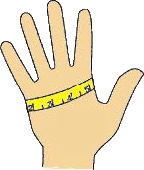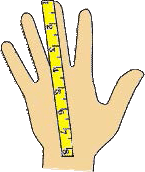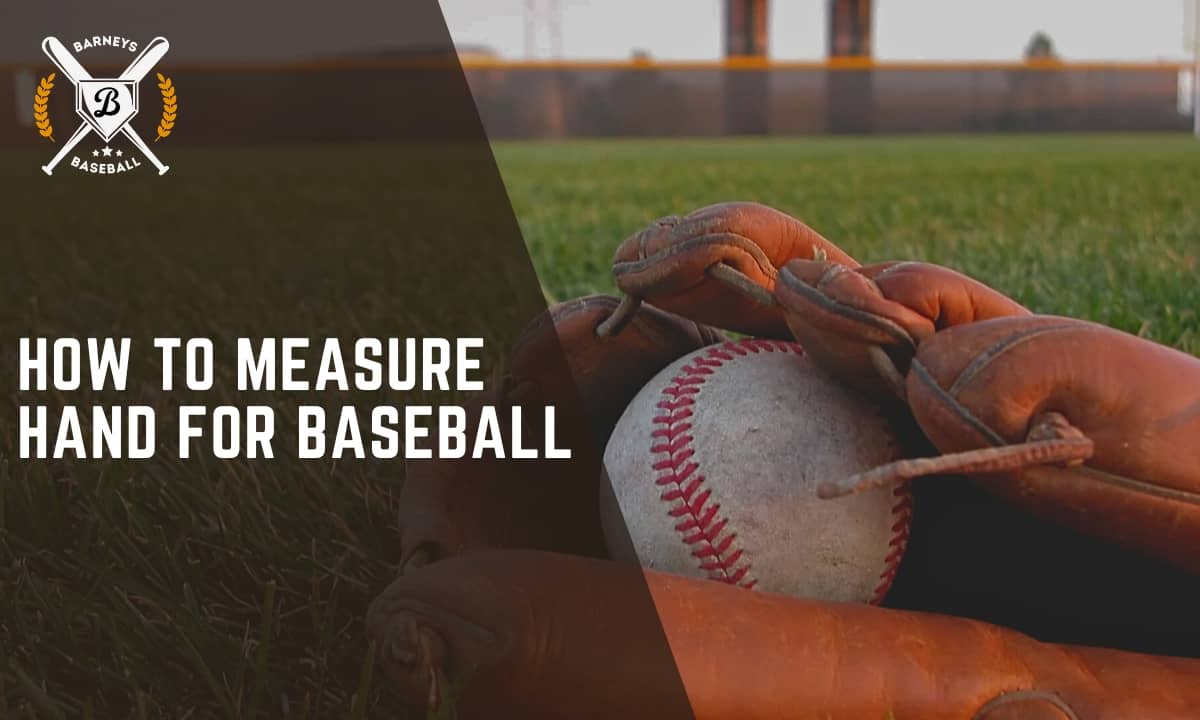How to measure hand for baseball glove, Properly measuring your hand for the perfect baseball glove fit is essential to enhance your performance on the field. This ultimate guide provides detailed insights on understanding hand measurements, choosing the right glove size, testing the fit, and breaking in your glove.
Key Takeaways
- Accurate hand measurements are crucial for finding the ideal baseball glove size.
- Consult sizing charts and try different styles to ensure a comfortable and secure fit.
- Consider your playing position when selecting a glove size for optimal performance.
- Test the glove’s range of motion, comfort, and closure to ensure a proper fit.
- Properly break in your glove through conditioning, maintenance, and techniques to extend its lifespan and performance.
Understanding Hand Measurements

Importance of Hand Size
The size of your hand is a fundamental factor in selecting a baseball glove that fits well and feels comfortable. A well-fitted glove is crucial for top-notch performance and will become a perfect extension of your hand, enhancing your game. Not only does the right glove size allow for better control and grip, but it also contributes to the overall health of your hand by reducing the risk of injury.
To ensure a perfect fit, you’ll need to provide accurate hand measurements. This includes the length and width of your hand, as well as finger length, which plays a significant role in achieving an optimal fit and enhanced flexibility. If the fingers of the glove are too short, it can restrict movement and affect your ability to play effectively.
Remember, the quality of material matters just as much as the size. A glove made from high-quality leather will mold to your hand over time, providing a custom-like fit.
When considering hand size, it’s important to refer to a baseball glove size chart. This chart will help you translate your hand measurements into the appropriate glove size. Here’s a simplified example of what such a chart might look like:
| Age Group | Hand Size (inches) |
|---|---|
| Youth | 6 – 6.75 |
| Teen | 6.75 – 7 |
| Adult | 7+ |
Measuring Techniques
To ensure a perfect fit for your baseball glove, accurate hand measurement is crucial. Begin by measuring the length of your hand from the base of your palm to the tip of your middle finger. This measurement will be your primary guide when consulting a glove size chart. Use a flexible measuring tape for precision, and if possible, have someone assist you to ensure the tape is positioned correctly.
Consistency is key when measuring your hand multiple times. Record the measurements to the nearest eighth of an inch to avoid rounding errors. Here’s a simple step-by-step process:
- Place your hand flat on a table.
- Stretch your fingers out fully.
- Measure from the base of your palm to the tip of your middle finger.
- Note the measurement in inches.
Remember, a well-measured hand leads to a well-fitted glove. Do not rush the process, and always double-check your measurements.
When referencing a glove size chart, as mentioned in the “Top 6 Best Outfield Gloves For Baseball in 2024”, it’s important to match your hand measurement with the corresponding glove size. For youth players, the “Youth Gloves for Kids: Boys & Girls Mitts | BaseballMonkey” guide provides additional sizing information. Adults, particularly men, may find the sizing chart in “A Guide to Men’s Gloves – How To Buy Stylish Gloves” useful, although baseball glove sizing can be more nuanced than standard glove sizes.
Common Mistakes to Avoid
When measuring your hand for a baseball glove, precision is crucial. Avoid using flexible measuring tapes, as they can stretch and give inaccurate results. Instead, opt for a rigid ruler or a tailor’s tape. Here are some common pitfalls to steer clear of:
- Relying solely on age and skill level to determine size
- Ignoring the glove’s design for specific positions
- Choosing a glove based on brand over fit and comfort
- Over-conditioning with oils or conditioners, which can weigh down the glove
Remember, a well-fitting glove is an extension of your hand. It should enhance your performance, not hinder it. Ensuring a snug fit—not too tight, nor too loose—is paramount for optimal control and comfort on the field.
Lastly, never attempt to speed up the break-in process by baking or steaming your glove. This can damage the leather and compromise the glove’s integrity. Instead, focus on gradually working the leather through regular use and proper conditioning.
6 Easy Steps
- Measure around the hand at the fullest part (exclude thumb)

- Measure from the tip of the middle finger to the base of the hand

- Use the largest of these two measurements for the correct size glove
- If you are right handed, take measurements from your right hand
- If you are left handed, take measurements from your left hand
- The number of inches measured equals the size of the glove
Choosing the Right Glove Size

Sizing Charts
Once you have your hand measurements, the next step is to consult a sizing chart to find the perfect glove fit. Glove sizing charts are essential tools that translate your hand measurements into the ideal glove size. These charts typically categorize glove sizes by age, position, and specific hand measurements, ensuring that players of all levels can find a glove that fits like a second skin.
For optimal comfort and performance, it’s crucial to select a glove size that matches your hand measurements precisely.
Here’s a simplified example of a baseball glove sizing chart:
| Age Group | Position | Glove Size (inches) |
|---|---|---|
| Youth | Infield | 9 – 11 |
| Teen | Outfield | 11 – 12.5 |
| Adult | Catcher | 32.5 – 34.5 |
Remember, while a sizing chart is a great starting point, it’s also important to try on different styles and brands, as sizing can vary. By using a size chart, you can accurately determine your glove size and increase your chances of finding a glove that allows you to make those game-winning plays with confidence.
Trying Different Styles
When selecting a baseball glove, it’s crucial to try different styles to find the one that best suits your hand and playing style. Each glove style is designed with specific positions in mind, offering varying degrees of padding, pocket depth, and wrist adjustments. For example, infielders often prefer a smaller glove for quick ball transfer, while outfielders may choose a larger glove for extended reach.
Infield gloves typically range from 11″ to 12″, and outfield gloves from 12.5″ to 12.75″. Catchers and first basemen have unique mitt designs tailored to their roles. Here’s a simple breakdown:
- Infield: 11″ – 12″
- Outfield: 12.5″ – 12.75″
- Catcher: 32.5″ – 34.5″
- First Base: 12″ – 13″
Remember, the best glove is one that feels like an extension of your hand. It should allow for seamless play without hindering movement.
While sizing charts provide a good starting point, nothing replaces the experience of trying on different gloves. Pay attention to how each glove feels when you open and close your hand, and consider the ease of fielding and transferring the ball. The right glove will not only fit well but also enhance your performance on the field.
Considerations for Position
When selecting a baseball glove, the player’s position on the field plays a crucial role in determining the appropriate glove design and size. Infielders, for example, often prefer smaller gloves that allow for quick transfers and rapid plays. On the other hand, outfielders typically opt for larger gloves with deeper pockets to aid in catching fly balls.
Catchers and first basemen use specialized gloves designed for their unique roles. A catcher’s mitt is heavily padded and larger to handle the pitcher’s throws, while a first baseman’s glove is longer to assist in scooping up ground balls.
Here’s a quick reference for glove sizes based on position:
- Infielders: 11″ – 11.75″
- Outfielders: 12″ – 12.75″
- Catchers: 32.5″ – 34.5″
- First Basemen: 12″ – 13″
It’s essential to consider how the glove’s size and style will affect your performance on the field. A glove that’s too large can hinder your ability to make quick plays, while one that’s too small may not provide adequate protection or catching ability.
Ultimately, the choice of glove should be a balance between the demands of your position, your playing style, and your personal comfort. Remember, the best glove is one that feels like an extension of your hand.
Testing the Fit

Range of Motion
Once you have a glove that seems to fit your hand measurements, it’s crucial to test the range of motion. A proper baseball glove should not restrict your ability to move your hand and fingers freely. This is essential for batting, throwing, and catching, as a limited range of motion can hinder your performance and increase the risk of injury.
Comfort is key when testing the range of motion. You should be able to flex your wrist and use all your fingers without feeling constrained. Pay attention to how the glove behaves when you simulate the motions of your position. For example, a pitcher’s glove should allow for a full range of motion to accommodate the combination of shoulder, elbow, and wrist motion required for different pitches.
Ensure that the glove does not impede your hand’s natural movement. The glove should feel like an extension of your hand, allowing for fluid motion and quick reactions.
Remember, the fit of the glove can also be affected by the materials and design. Some gloves may require a break-in period before they offer optimal range of motion. Always refer to the manufacturer’s guidelines for breaking in your glove to avoid damaging it or compromising its integrity.
Comfort and Flexibility
When selecting a baseball glove, comfort and flexibility are paramount to ensure optimal performance. A glove that feels like an extension of your hand will not only enhance your play but also reduce the risk of injury. Look for features such as the M Type fit system, which provides tailored thumb and pinky sleeves, as well as enhanced thumb stall cushioning. This design detail contributes to a glove that molds to your hand for a comfortable fit.
The right glove should allow for a full range of motion, enabling you to open and close it with ease. It should not pinch or restrict movement, and the palm lining should offer a snug yet flexible feel.
To assess the flexibility of a glove, consider the materials and construction. Gloves with a short break-in period are often more pliable and ready for immediate use. Below is a list of factors to consider when testing for comfort and flexibility:
- Quality of the leather
- Type of palm lining, such as Pittards Sheepskin
- Presence of adjustable straps or a conventional open back
- Overall glove design, including unique features like a glove wrap
Remember, a well-fitting glove is crucial for maintaining control and precision during the game.
Checking for Proper Closure
Ensuring that your baseball glove has the proper closure is crucial for performance and safety. Most gloves come with adjustable straps or laces, allowing you to customize the fit to your hand. A well-adjusted closure will keep the glove snugly in place, preventing it from slipping off during play.
Closure mechanisms vary from glove to glove, with options like Velcro, buckles, or laces. It’s important to choose a method that feels secure and is easy for you to operate. For instance, a generous Velcro closure can accommodate any size glove and is simple to adjust.
Remember, the closure should be tight enough to maintain control of the glove, but not so tight that it cuts off circulation or hinders movement.
If you’re using additional hand protection, such as a sting pad, ensure it fits comfortably under the glove without affecting the closure. A slim profile pad that fits right under your glove can be effective without being obtrusive. Lastly, when storing your glove, secure the bag properly to protect it from dust and moisture. Whether it’s a zipper closure or a drawstring, a secure closure on your glove bag is just as important for maintaining the life of your glove.
Breaking in Your Glove

Proper Conditioning
Proper conditioning of your baseball glove is essential to ensure both longevity and optimal performance. Conditioning your glove helps maintain the leather’s suppleness, preventing it from becoming brittle and cracking over time. A well-conditioned glove will also mold to your hand shape better, providing a more personalized fit.
When conditioning your glove, it’s important to use products designed specifically for leather care, such as the SARNA Baseball Softball Glove Oil or the SARNA Baseball Glove Leather Conditioner Cream. These products are formulated to soften, hydrate, and break in your glove without damaging the leather. Users often prefer the cream for its ease of application and less messy experience.
After applying the conditioner, let the leather live in the product. Leather takes time to absorb the conditioner, so place the glove in a clean area for around 20-30 minutes to allow for proper absorption.
Remember, this extra conditioning step not only keeps the glove soft but also helps by keeping dirt and debris out of the newly stretched leather pores. Hydrating the leather is crucial for a glove that feels and performs at its best.
Speeding up the Process
Once you’ve selected the perfect baseball glove, you’ll want to make it game-ready as soon as possible. Breaking in your glove is a crucial step to ensure optimal performance and comfort. There are several methods to speed up this process, each with its own merits.
One popular technique involves the use of specialized kits, such as those found on Amazon.com, which are designed to protect and condition your glove while speeding up the break-in period. These kits often come with conditioners and mallets to help shape the glove to your hand.
Another method recommended by MLB players involves a simple four-step routine. This process includes working the leather, applying conditioner, shaping the glove, and using it in play. Engaging in a game of catch is a practical way to naturally work the glove to the shape of your hand and the ball.
For those looking for a home remedy, applying a generous amount of shaving cream to the glove can also expedite the softening of the leather. Massaging the cream into the glove helps make the material more pliable.
Remember, while it’s important to break in your glove quickly, it’s equally important to do it correctly to maintain the integrity of the leather and ensure the glove’s longevity.
Maintaining the Glove
Maintaining your baseball glove is crucial for ensuring its longevity and performance. Regular care is essential, not only after breaking in your glove but throughout its life. A well-maintained glove can be a reliable partner on the field for many seasons.
Cleaning your glove should be a routine part of your post-game or practice activities. After each use, it’s important to wipe down the glove with a soft, dry cloth to remove any dirt and moisture. For a deeper clean, especially if the glove has been exposed to a lot of dust or mud, using a leather cleaner is advisable. However, always avoid harsh chemicals that can damage the leather.
At least once a season, take the time to give your glove a thorough tune-up. This includes tightening the laces and applying leather conditioner to keep the material supple and prevent it from drying out.
When applying leather conditioner, use only a small amount on a clean cloth, and gently rub it into the leather, focusing on areas that seem particularly dry or stiff. This will help maintain the glove’s flexibility and ensure a comfortable fit. Remember, a well-cared-for glove is a key component of your defensive game.
Conclusion
In conclusion, measuring your hand for the perfect baseball glove fit is essential to enhance your performance on the field. By following the steps outlined in this guide, you can ensure that your glove fits comfortably and securely, allowing you to make precise catches and throws. Remember, a well-fitted glove can make a significant difference in your game, so take the time to measure your hand accurately and choose the right size. Play ball with confidence and comfort with the perfect baseball glove fit!
how to measure hand for baseball glove FAQs
How do I know if I have measured my hand correctly for a baseball glove?
Ensure you follow the measuring techniques accurately and compare your measurements to sizing charts.
What should I do if the glove feels too tight or too loose after measuring?
Consider trying different styles or sizes to find the best fit for your hand.
Can hand shape affect the fit of a baseball glove?
Yes, hand shape plays a role in how a glove fits, so choose a glove that accommodates your hand shape.
How important is comfort when choosing a baseball glove?
Comfort is crucial for performance and injury prevention, so prioritize comfort when selecting a glove.
How can I speed up the process of breaking in my baseball glove?
Proper conditioning, using glove oil, and consistent use can help speed up the breaking-in process.
What is the best way to maintain the quality of my baseball glove?
Regularly clean and condition your glove, store it properly, and avoid exposing it to extreme conditions for longevity.
